Investigation of the Effect of Albedo in Photovoltaic Systems for Urban Applications: Case Study for Spain
Abstract
1. Introduction
- (i)
- We analyze the equations proposed by the Spanish regulations for the determination of the annual optimum tilt angle.
- (ii)
- We determine the error caused through the use of the equations based on the latitude that do not take into account the variation of the albedo.
- (iii)
- We propose a method to compute the annual optimum tilt angle that accounts for the albedo variations.
- (iv)
- We conduct a detailed analysis of the relative energy harvesting as a function of different variables.
- (v)
- Finally, a simplified polynomial regression model to estimate optimum tilt angle as a function of latitude, altitude and albedo is proposed.
2. A Case Study in Spain
3. Background
3.1. Solar Irradiance Estimation Model
3.2. Estimation of the Amount of Total Irradiation on a Tilted Plane
4. Procedure
- (i)
- The effect of the weather conditions for each city under study is taken into account with the method proposed by [31].
- (ii)
- The Mathematica code uses the satellite-derived data [50] for each city under study as inputs of monthly-averaged beam and diffuse solar irradiation.
- (iii)
- Any albedo value can be used.
- (iv)
- The study was carried out in Spain. However, the procedure can be applied anywhere in the world.
4.1. Computation of the Optimum Tilt Angle
4.1.1. Technical Report by the Spanish Institute for the Diversification and Saving of Energy (IDAE)
4.1.2. Other Equations
4.1.3. Cavaleri’s Principle
4.2. Energy Harvesting
5. Results and Discussion
5.1. Equations as Function of Latitude
- (i)
- The annual solar irradiation for each city is consistently higher as the albedo increases.
- (ii)
- For , the three models closely match. Lorenzo’s and Jacobson’s equations obtain very similar total annual irradiation values. The maximum of total yearly irradiation is in the case of ’s guidelines, for Lorenzo’s equation, and for Jacobson’s equation. The deviations are not greater than . The reflectivity of most types of ground surfaces is rather low; therefore, the contribution of this type of solar irradiance falling on a module is low. When no specific albedo values are available, the value of is typically assumed [47]. Therefore, in this case, these equations are valid.
- (iii)
- For , Lorenzo’s equation and Jacobson’s equation still obtain very similar total annual irradiation values. However, the recommendation begins to worsen its results. The maximum of total annual irradiation is for guideline, for Lorenzo’s equation, and for Jacobson’s equation.
- (iv)
- For , the recommendation worsens its results by compared with , and Lorenzo’s equation and Jacobson’s equation in . The maximum of total annual irradiation is for guideline, for Lorenzo’s equation, and for Jacobson’s equation.
- (v)
- For , Lorenzo’s equation and Jacobson’s equation still obtain very similar total annual irradiation values, but their results are worsened by compared with . recommendation obtains the worst results. The maximum of total annual irradiation is for the guidelines, for Lorenzo’s equation, and for Jacobson’s equation.
- (vi)
- The reason for the small difference between the results obtained by using Lorenzo’s equation and Jacobson’s equation is that they are based on the same procedure. For locations with , Jacobson’s equation yields better results. For , Lorenzo’s equation obtains better results. For , both equations produce the same results.
5.2. Method Based on to Maximize the Total Irradiation Incident on a Tilted Surface
- (i)
- The method that maximizes the total irradiation incident on a tilted surface obtains the best results.
- (ii)
- For , the three equations closely match with the method that maximizes the total irradiation incident on a tilted surface.
- (iii)
- For , Lorenzo’s equation and Jacobson’s equation continue to give very similar values for total annual irradiation. However, the recommendation begins to worsen its results. The maximum of total annual irradiation is for the guideline, for Lorenzo’s equation, and for Jacobson’s equation.
- (iv)
- For , the recommendation worsens its results by compared with , and Lorenzo’s equation and Jacobson’s equation worsen by . The maximum of total annual irradiation is for the guideline, for Lorenzo’s equation, and for Jacobson’s equation.
- (v)
- For , Lorenzo’s equation and Jacobson’s equation still obtain very similar total annual irradiation values, but their results are worsened by compared with . The recommendation obtains the worst results. The maximum of total annual irradiation is for the guideline, for Lorenzo’s equation, and for Jacobson’s equation.
- (vi)
- The greater the albedo, the greater the error introduced by the three models, since they only account for the latitude of the place. The results suggest that the proposed optimization method is able to take into account the variation of the albedo.
- (vii)
- With increased albedo, the guideline obtains the worst results
- (viii)
- It is recommended to use Lorenzo’s equation and Jacobson’s equation for the cities studied for .
5.3. Simplified Model for the Annual Optimum Tilt Angle
6. Conclusions
- (i)
- The use of the equations as a function of latitude increases the annual by increasing the albedo. When the albedo was , the annual was very similar for all three equations. Lorenzo’s and Jacobson’s models did not appreciably change the annual in the range of albedos studied.
- (ii)
- With regard to single-axis tracker, the minimum and maximum value of the percentage of per year obtained were () and () for ’s guideline, () and () for Lorenzo’s model, () and () for Jacobson’s model.
- (iii)
- The annual was increased when the equations as a function of latitude were used, compared with the method that maximizes the total irradiation incident on a tilted surface. This increase is stronger for albedo values equal to .
- (iv)
- The yearly optimum tilt angle is higher as albedo increases. Therefore, equations that only depend on latitude are less accurate as the albedo increases. With regard to the method that maximizes the total irradiation incident on a tilted surface, the minimum and maximum value of the percentage of per year obtained were and for guideline, and for Lorenzo’s equation, and and for Jacobson’s equation.
- (v)
- We have obtained two linear models that account for the latitude, albedo and the altitude of the location to predict the optimum tilt angle. We believe that these formulae show great simplicity of use with acceptable accuracy.
Author Contributions
Funding
Data Availability Statement
Conflicts of Interest
Nomenclature
| Adjusted total irradiation on a tilted surface (Wh/m) | |
| Adjusted annual total irradiation (Wh/m) | |
| Adjusted beam irradiance on a horizontal surface (W/m) | |
| Adjusted beam irradiance on a tilted surface (W/m) | |
| Adjusted diffuse irradiance on a horizontal surface (W/m) | |
| Adjusted difuse irradiance on a tilted surface (W/m) | |
| Adjusted ground reflected irradiance on a tilted surface (W/m) | |
| Adjusted total irradiance on a tilted surface (W/m) | |
| n | Ordinal of the day (day) |
| Relative energy harvesting (%) | |
| T | Solar time (h) |
| Sunrise solar time (h) | |
| Sunset solar time (h) | |
| Height angle of the Sun () | |
| Tilt angle of photovoltaic module () | |
| Optimal annual tilt angle () | |
| Azimuth angle of photovoltaic module () | |
| Azimuth of the Sun () | |
| Solar declination () | |
| Incidence angle () | |
| Zenith angle of the Sun () | |
| Latitude angle () | |
| Ground reflectance (dimensionless) | |
| Hour angle () |
References
- United Nations. Doha Amendment to the Kyoto Protocol; Adopted, Decision 1/CMP; C.N.718.2012.TREATIES-XXVII.7.c; United Nations: Rome, Italy, 2012; Volume 8. [Google Scholar]
- Barbón, A.; Ayuso, P.F.; Bayxoxn, L.; Silva, C.A. A comparative study between racking systems for photovoltaic power systems. Renew. Energy 2021, 180, 424–437. [Google Scholar] [CrossRef]
- Ghodbane, M.; Boumeddane, B.; Said, Z.; Bellos, E. A numerical simulation of a linear Fresnel solar reflector directed to produce steam for the power plant. J. Clean. Prod. 2019, 231, 494–508. [Google Scholar] [CrossRef]
- Byrne, J.; Hughes, K.; Toly, N.; Wang, Y.-D. Can cities sustain life in the greenhouse? Bull. Sci. Technol. Soc. 2006, 26, 84–95. [Google Scholar] [CrossRef]
- In Focus: Energy Efficiency in Buildings. Available online: https://ec.europa.eu/info/news/focus-energy-efficiency-buildings-2020-feb-17_en (accessed on 23 July 2022).
- Economidou, M.; Todeschi, V.; Bertoldi, P.; D’Agostino, D.; Zangheri, P.; Castellazzi, L. Review of 50 years of EU energy efficiency policies for buildings. Energy Build. 2020, 225, 110322. [Google Scholar] [CrossRef]
- Gulkowski, S. Specific Yield Analysis of the Rooftop PV Systems Located in South-Eastern Poland. Energies 2022, 15, 3666. [Google Scholar] [CrossRef]
- Child, M.; Kemfert, C.; Bogdanov, D.; Breyer, C. Flexible electricity generation, grid exchange and storage for the transition to a 100% renewable energy system in Europe. Renew. Energy 2019, 139, 80–101. [Google Scholar] [CrossRef]
- Gómez-Navarro, T.; Brazzini, T.; Alfonso-Solar, D.; Vargas-Salgado, C. Analysis of the potential for PV rooftop prosumer production: Technical, economic and environmental assessment for the city of Valencia (Spain). Renew. Energy 2021, 174, 372–381. [Google Scholar] [CrossRef]
- Jacobson, M.Z.; Delucchi, M.A.; Bauer, Z.A.F.; Goodman, S.C.; Chapman, W.E.; Cameron, M.A.; Bozonnat, C.; Chobadi, L.; Clonts, H.A.; Enevoldsen, P.; et al. 100% clean and renewable wind, water, and sunlight (WWS) all-sector energy roadmaps for 139 countries of the world. Joule 2017, 1, 108–121. [Google Scholar] [CrossRef]
- Buonocore, J.J.; Luckow, P.; Norris, G.; Spengler, J.D.; Biewald, B.; Fisher, J.; Levy, J.I. Health and climate benefits of different energy-efficiency and renewable energy choices. Nat. Clim. Chang. 2016, 6, 100–105. [Google Scholar] [CrossRef]
- Peng, J.; Lu, L. Investigation on the development potential of rooftop PV system in Hong Kong and its environmental benefits. Renew. Sustain. Energy Rev. 2013, 27, 149–162. [Google Scholar] [CrossRef]
- Arcos-Vargasa, A.; Cansino, J.M.; Román-Collado, R. Economic and environmental analysis of a residential PV system: A profitable contribution to the Paris agreement. Renew. Sustain. Energy Rev. 2018, 94, 1024–1035. [Google Scholar] [CrossRef]
- Jan, I.; Ashfaq, W.U.M. Social acceptability of solar photovoltaic system in Pakistan: Key determinants and policy implications. J. Clean. Prod. 2020, 274, 123140. [Google Scholar] [CrossRef]
- Assouline, D.; Mohajeri, N.; Scartezzini, J.-L. Quantifying rooftop photovoltaic solar energy potential: A machine learning approach. Sol. Energy 2017, 141, 278–296. [Google Scholar] [CrossRef]
- Ordóñez, J.; Jadraque, E.; Alegre, J.; Martínez, G. Analysis of the photovoltaic solar energy capacity of residential rooftops in Andalusia (Spain). Renew. Sustain. Energy Rev. 2010, 14, 2122–2130. [Google Scholar] [CrossRef]
- Duffie, J.A.; Beckman, W.A. Solar Engineering of Thermal Processes, 4th ed.; John Wiley & Sons: New York, NY, USA, 2013. [Google Scholar]
- Raptis, I.-P.; Moustaka, A.; Kosmopoulos, P.; Kazadzis, S. Selecting Surface Inclination for Maximum Solar Power. Energies 2022, 13, 4784. [Google Scholar] [CrossRef]
- Barbón, A.; Ghodbane, M.; Bayxoxn, L.; Said, Z. A general algorithm for the optimization of photovoltaic modules layout on irregular rooftop shapes. J. Clean. Prod. 2022, 365, 132774. [Google Scholar] [CrossRef]
- Ullah, A.; Imran, H.; Maqsood, Z.; Butt, N.Z. Investigation of optimal tilt angles and effects of soiling on PV energy production in Pakistan. Renew. Energy 2019, 139, 830–843. [Google Scholar] [CrossRef]
- Lorenzo, E. Energy collected and delivered by PV modules. In Handbook of Photovoltaic Science and Engineering; John Wiley & Sons: Hoboken, NJ, USA, 2011; pp. 984–1042. [Google Scholar]
- Jacobson, M.Z.; Jadhav, V. World estimates of PV optimal tilt angles and ratios of sunlight incident upon tilted and tracked PV panels relative to horizontal panels. Sol. Energy 2018, 169, 55–66. [Google Scholar] [CrossRef]
- Nicolás-Martín, C.; Santos-Martín, D.; Chinchilla-Sxaxnchez, M.; Lemon, S. A global annual optimum tilt angle model for photovoltaic generation to use in the absence of local meteorological data. Renew. Energy 2020, 161, 722–735. [Google Scholar] [CrossRef]
- Soulayman, S.; Hammoud, M. Optimum tilt angle of solar collectors for building applications in mid-latitude zone. Energy Convers. Manag. 2016, 124, 20–28. [Google Scholar] [CrossRef]
- Al Garni, H.Z.; Awasthi, A.; Wright, D. Optimal orientation angles for maximizing energy yield for solar PV in Saudi Arabia. Renew. Energy 2019, 133, 538–550. [Google Scholar] [CrossRef]
- SOLARGIS. Available online: https://solargis.com/maps-and-gis-data/download/world (accessed on 9 July 2021).
- Danandeh, M.A.; Mousavi, S.M. Solar irradiance estimation models and optimum tilt angle approaches: A comparative study. Renew. Sustain. Energy Rev. 2018, 92, 319–330. [Google Scholar] [CrossRef]
- Antonanzas-Torres, F.; Urraca, R.; Polo, J.; Perpi nán-Lamigueiro, O.; Escobar, R. Clear sky solar irradiance models: A review of seventy models. Renew. Sustain. Energy Rev. 2019, 107, 374–387. [Google Scholar] [CrossRef]
- Salazar, G.; Gueymard, C.; Galdino, J.B.; Castro Vilela, O. Solar irradiance time series derived from high-quality measurements, satellite-based models, and reanalyses at a near-equatorial site in Brazil. Renew. Sustain. Energy Rev. 2020, 117, 109478. [Google Scholar] [CrossRef]
- Fan, J.; Chen, B.; Wu, L.; Zhang, F.; Lu, X. Evaluation and development of temperature-based empirical models for estimating daily global solar radiation in humid regions. Energy 2018, 144, 903–914. [Google Scholar] [CrossRef]
- Barbón, A.; Ayuso, P.F.; Bayxoxn, L.; Fernández-Rubiera, J.A. Predicting beam and diffuse horizontal irradiance using Fourier expansions. Renew. Energy 2020, 154, 46–57. [Google Scholar] [CrossRef]
- Hottel, H.C. A simple model for estimating the transmittance of direct solar radiation through clear atmosphere. Sol. Energy 1976, 18, 129–134. [Google Scholar] [CrossRef]
- Liu, B.Y.H.; Jordan, R.C. The interrelationship and characteristic distribution of direct, diffuse and total solar radiation. Sol. Energy 1960, 4, 1–19. [Google Scholar] [CrossRef]
- Barbón, A.; Bayxoxn-Cueli, C.; Bayxoxn, L.; Rodríguez-Suanzes, C. Analysis of the tilt and azimuth angles of photovoltaic systems in non-ideal positions for urban applications. Appl. Energy 2022, 305, 117802. [Google Scholar] [CrossRef]
- Barbón, A.; Fernández-Rubiera, J.A.; Martínez-Valledor, L.; Pérez-Fernxaxndez, A.; Bayxoxn, L. Design and construction of a solar tracking system for small-scale linear Fresnel reflector with three movements. Appl. Energy 2021, 285, 116477. [Google Scholar] [CrossRef]
- WRDC. World Radiation Data Centre. 2021. Available online: http://wrdc.mgo.rssi.ru/ (accessed on 9 July 2021).
- Liu, B.Y.H.; Jordan, R.C. The long-term average performance of flat-plate solar energy collectors. Sol. Energy 1963, 7, 53–74. [Google Scholar] [CrossRef]
- Bertrand, C.; Housmans, C.; Leloux, J.; Journée, M. Solar irradiation from the energy production of residential PV systems. Renew. Energy 2018, 125, 306–318. [Google Scholar] [CrossRef]
- Okoye, C.O.; Solyalı, O. Optimal sizing of stand-alone photovoltaic systems in residential buildings. Energy 2017, 126, 573–584. [Google Scholar] [CrossRef]
- Mehleri, E.D.; Zervas, P.L.; Sarimveis, H.; Palyvos, J.A.; Markatos, N.C. Determination of the optimal tilt angle and orientation for solar photovoltaic arrays. Renew. Energy 2010, 35, 2468–2475. [Google Scholar] [CrossRef]
- Coakley, J.A. Reflectance and albedo, surface. In Encyclopedia of the Atmosphere; Academic Press: Washington, DC, USA, 2003; pp. 1914–1923. [Google Scholar]
- Mamun, M.A.A.; Islam, M.M.; Hasanuzzaman, M.; Selvaraj, J. Effect of tilt angle on the performance and electrical parameters of a PV module: Comparative indoor and outdoor experimental investigation. Energy Built Environ. 2022, 3, 278–290. [Google Scholar] [CrossRef]
- Yadav, S.; Panda, S.K.; Tripathy, M. Performance of building integrated photovoltaic thermal system with PV module installed at optimum tilt angle and influenced by shadow. Renew. Energy 2018, 127, 11–23. [Google Scholar] [CrossRef]
- Muneer, T. Solar Radiation and Day Light Models, 1st ed.; Elsevier: Oxford, UK, 2004. [Google Scholar]
- Dobos, E. Albedo. In Encyclopedia of Soil Science; CRC Press: Boca Raton, FL, USA, 2006; Volume 2, pp. 24–25. [Google Scholar]
- Weihs, P.; Mursch-Radlgruber, E.; Hasel, S.; Gützer, C.; Brandmaier, M.; Plaikner, M. Investigation of the effect of sealed surfaces on local climate and thermal stress. In EGU General Assembly Conference Abstracts; Geophysical Research Abstracts: Vienna, Austria, 2015; p. 12616. [Google Scholar]
- Pérez-Gallardo, J.R.; Azzaro-Pantel, C.; Astier, S.; Domenech, S.; Aguilar-Lasserre, A. Ecodesign of photovoltaic grid-connected systems. Renew. Energy 2014, 64, 82–97. [Google Scholar] [CrossRef]
- Chinchilla, M.; Santos-Martín, D.; Carpintero-Rentería, M.; Lemon, S. Worldwide annual optimum tilt angle model for solar collectors and photovoltaic systems in the absence of site meteorological data. Appl. Energy 2021, 281, 116056. [Google Scholar] [CrossRef]
- Lv, Y.; Si, P.; Rong, X.; Yan, J.; Feng, Y.; Zhu, X. Determination of optimum tilt angle and orientation for solar collectors based on effective solar heat collection. Appl. Energy 2018, 219, 11–19. [Google Scholar] [CrossRef]
- PVGIS, Joint Research Centre (JRC). 2019. Available online: http://re.jrc.ec.europa.eu/pvg_tools/en/tools.html#PVP (accessed on 9 July 2022).
- IDAE. Technical Conditions for PV Installations Connected to the Grid. Report Available from the Publication Services of the Institute for Diversification and Energy Savings, Spain. Available online: http://www.idae.es (accessed on 10 September 2022). (In Spanish).
- Marzo, A.; Ferrada, P.; Beiza, F.; Besson, P.; Alonso-Montesinos, J.; Ballestrín, J.; Román, R.; Portillo, C.; Escobar, R.; Fuentealba, E. Standard or local solar spectrum? Implications for solar technologiesstudies in the Atacama desert. Renew. Energy 2018, 127, 871–882. [Google Scholar] [CrossRef]
- Fernández-Infantes, A.; Contreras, J.; Bernal-Agustín, J.L. Design of grid connected PV systems considering electrical, economical and environmental aspects: A practical case. Renew. Energy 2006, 31, 2042–2062. [Google Scholar] [CrossRef]
- Ascencio-Vásquez, J.; Brecl, K.; Topič, M. Methodology of Köppen-Geiger-Photovoltaic climate classification and implications to worldwide mapping of PV system performance. Sol. Energy 2019, 191, 672–685. [Google Scholar] [CrossRef]
- Tröndle, T.; Pfenninger, S.; Lilliestam, J. Home-made or imported: On the possibility for renewable electricity autarky on all scales in Europe. Energy Strategy Rev. 2019, 26, 100388. [Google Scholar] [CrossRef]
- Genetic Programming in Python, with a Scikit-Learn Inspired and Compatible API. 2021. Available online: https://github.com/trevorstephens/gplearn (accessed on 9 July 2022).

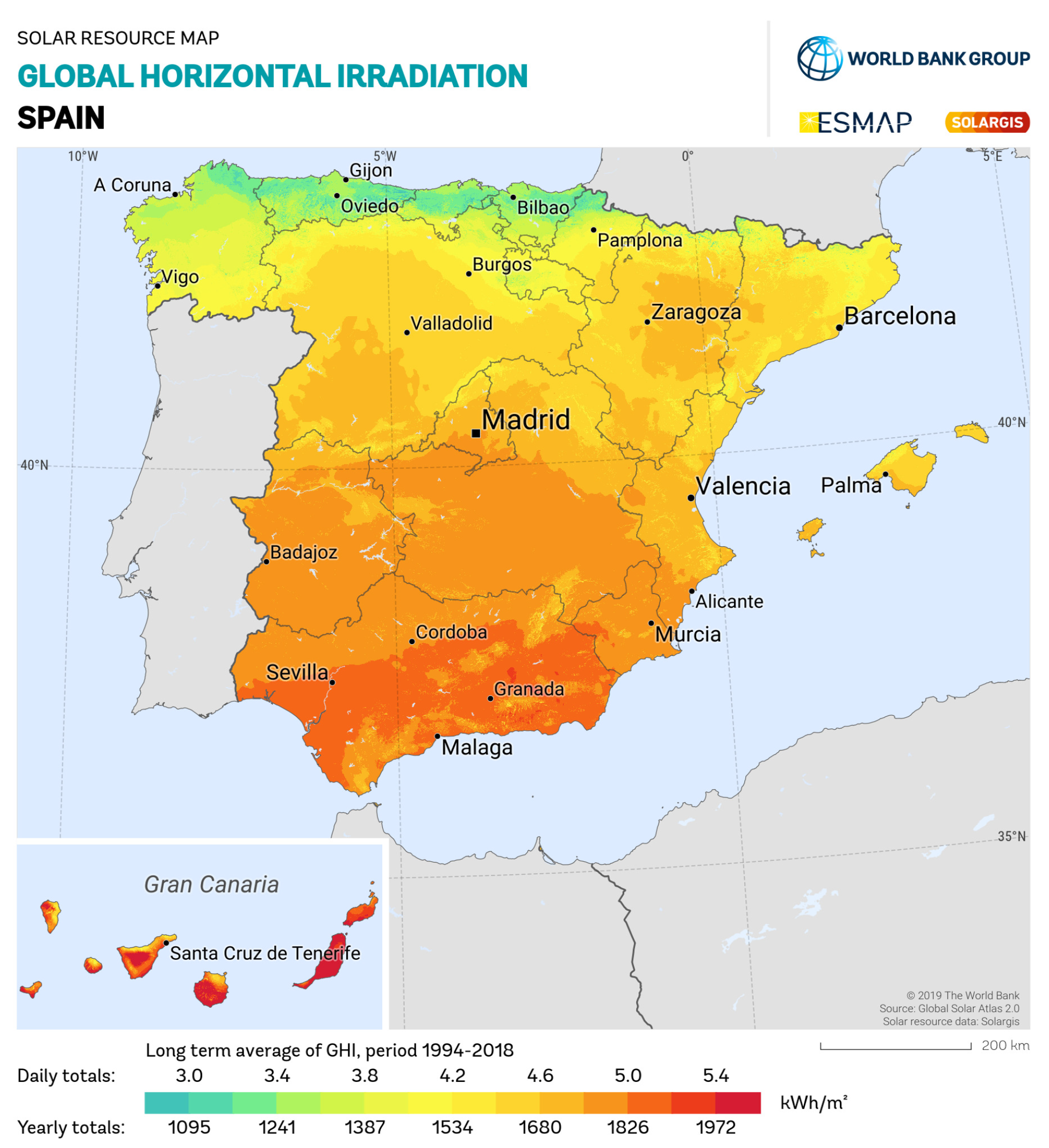
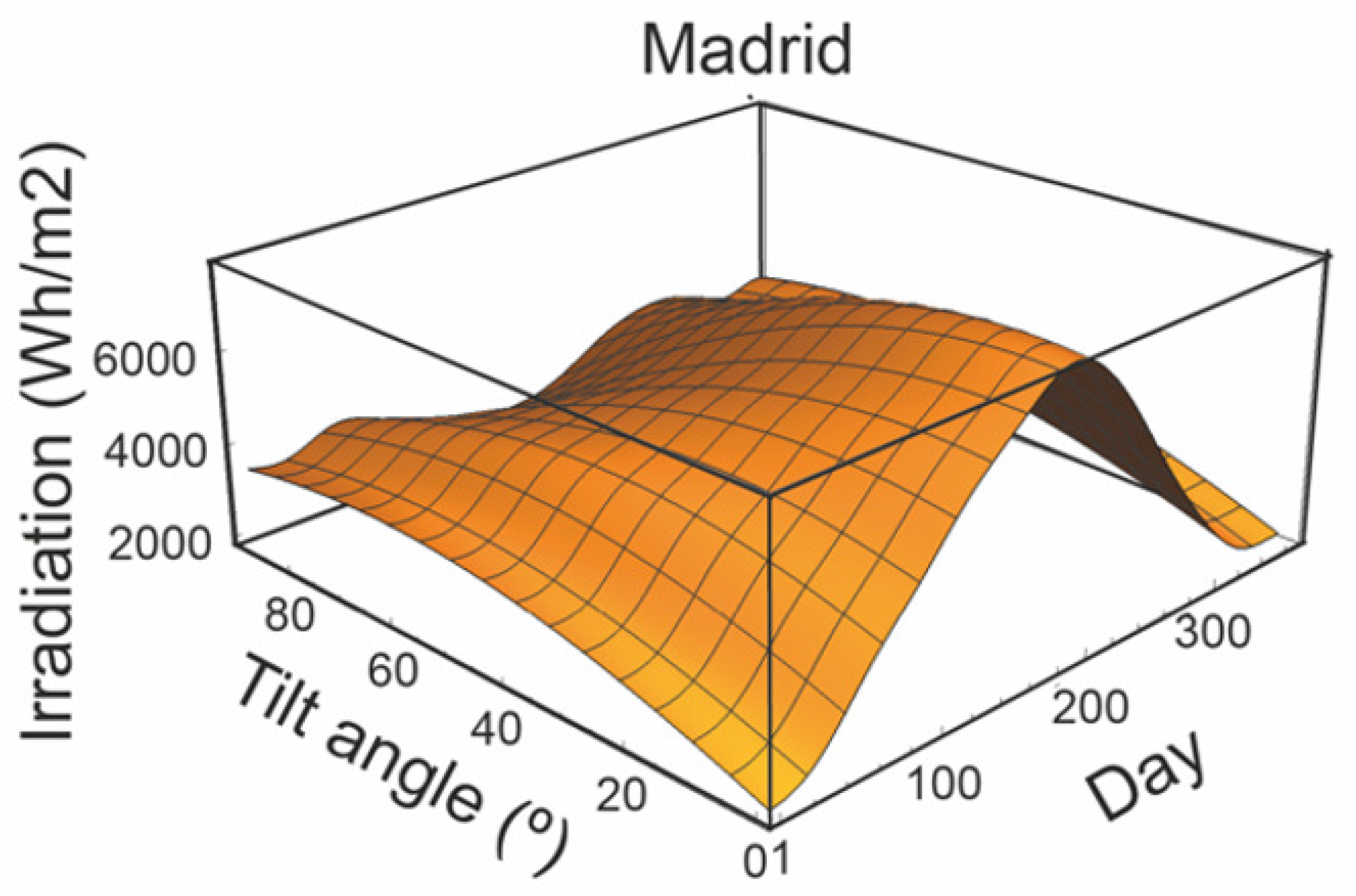
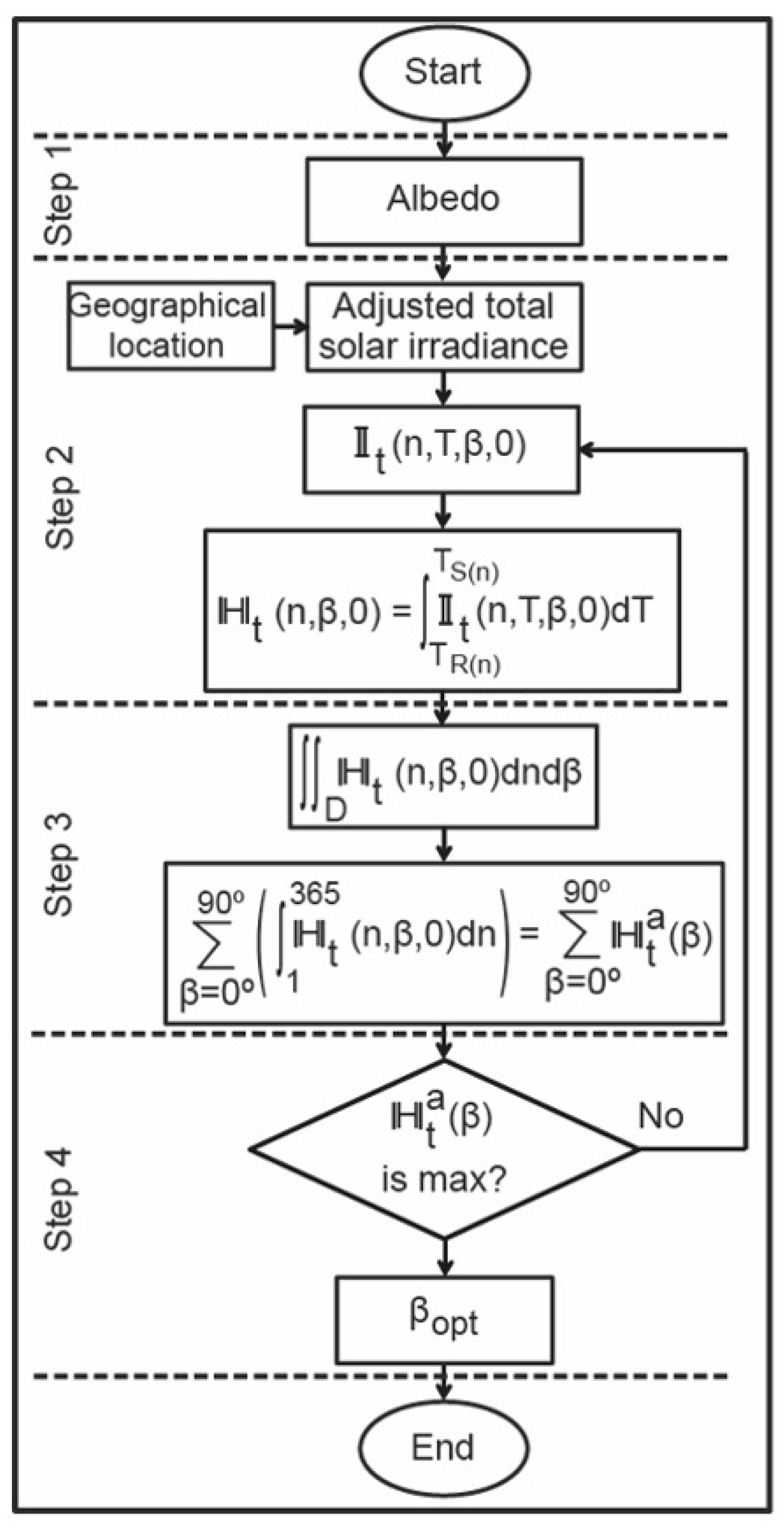

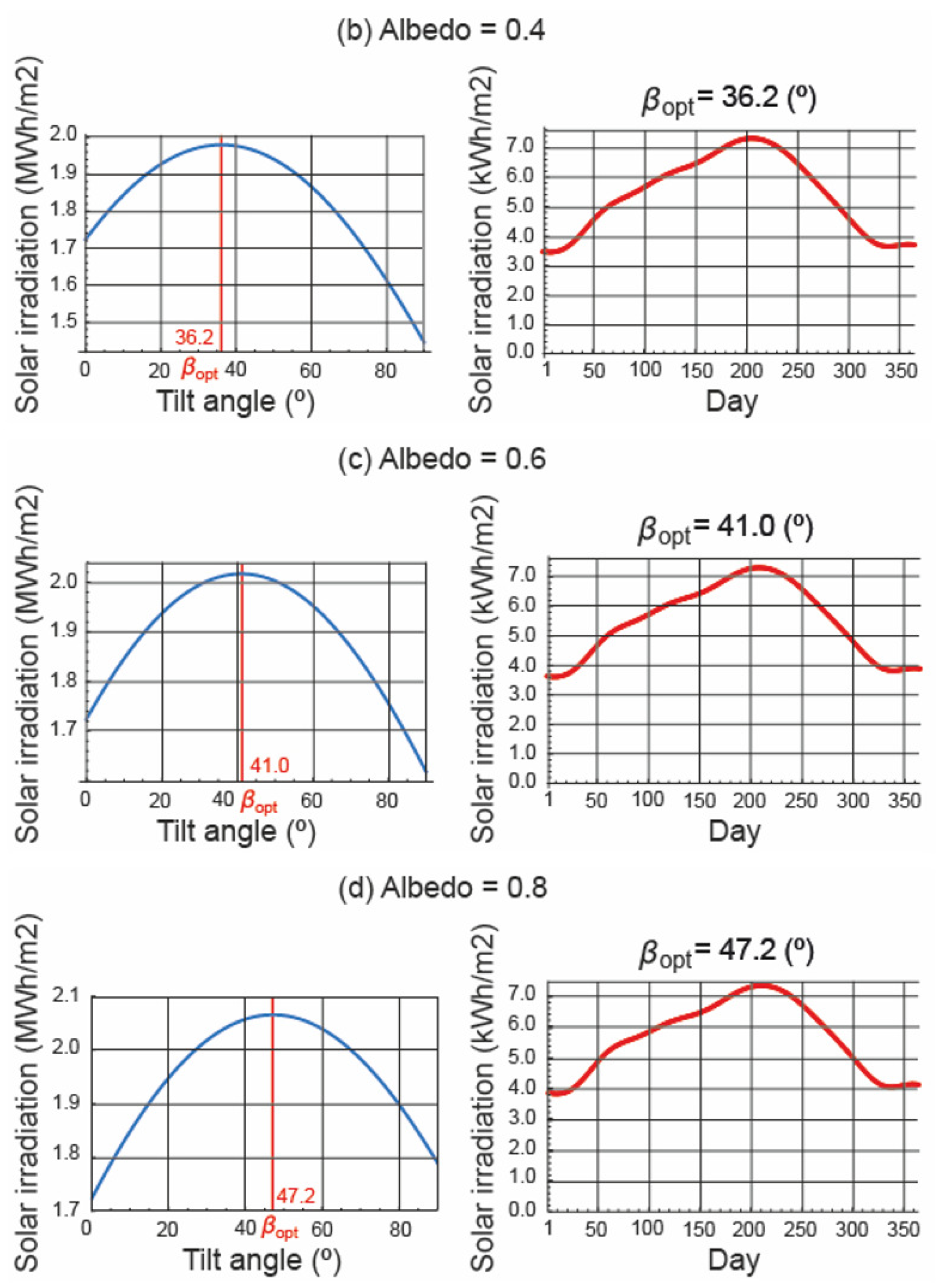
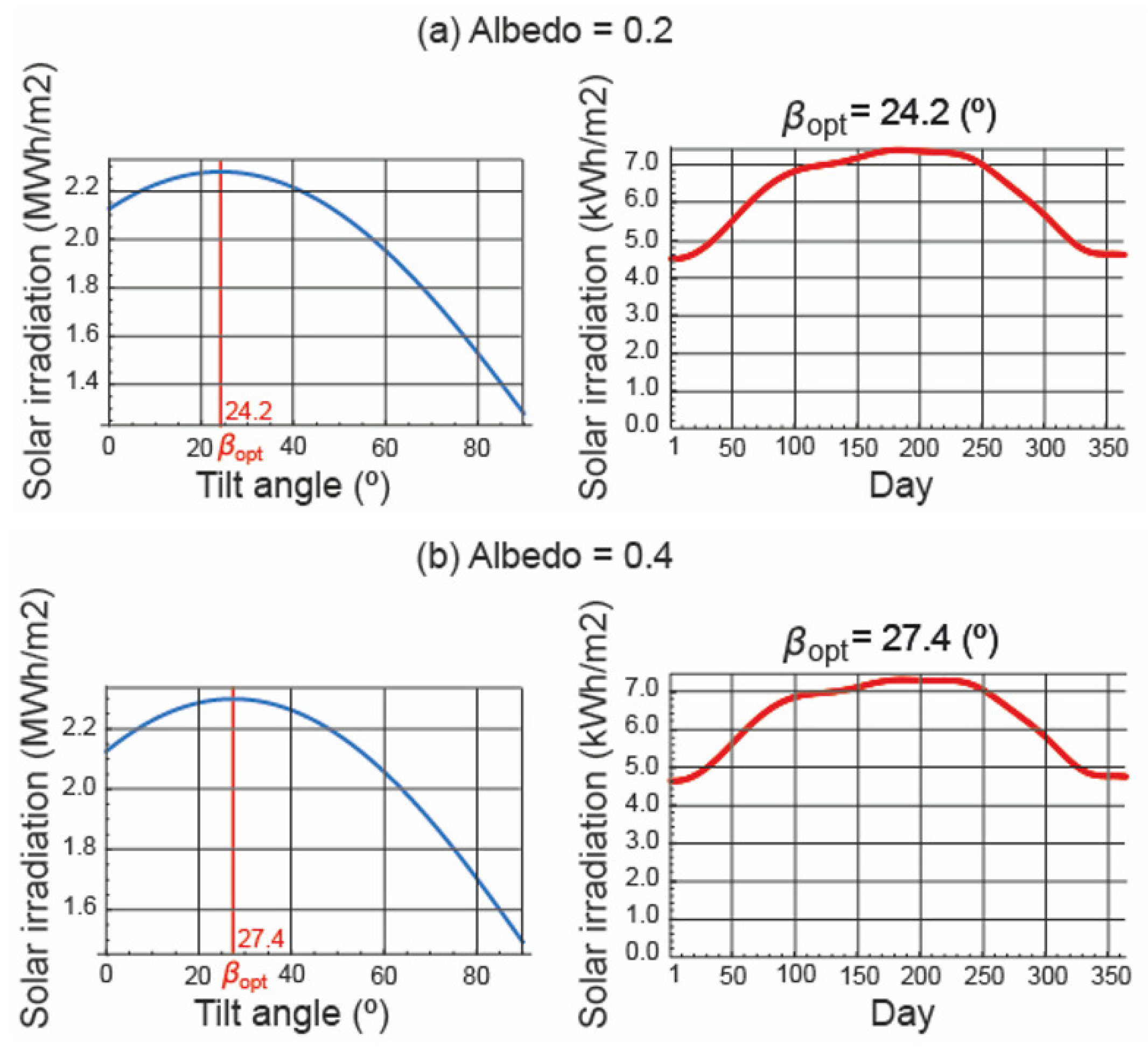
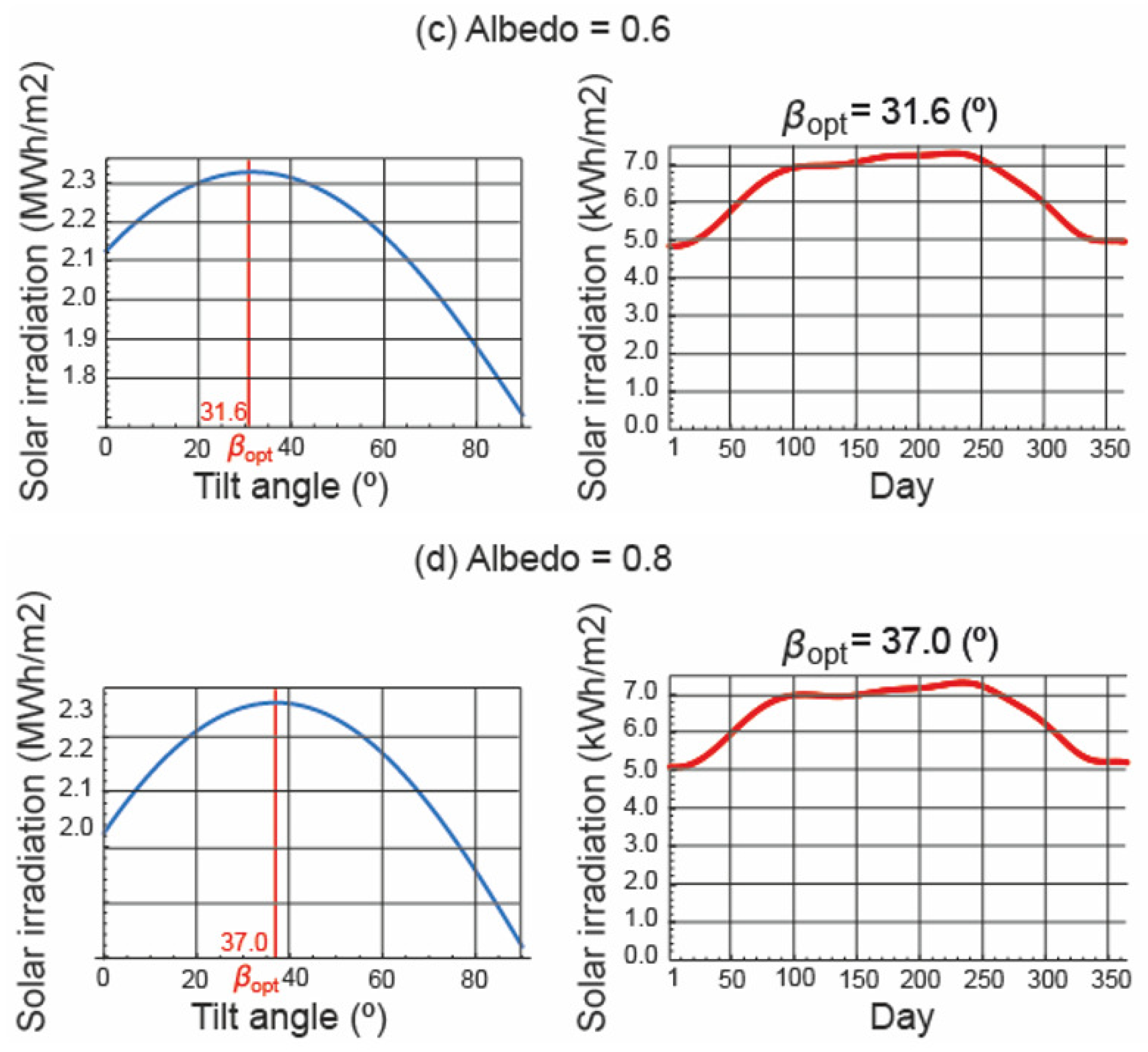


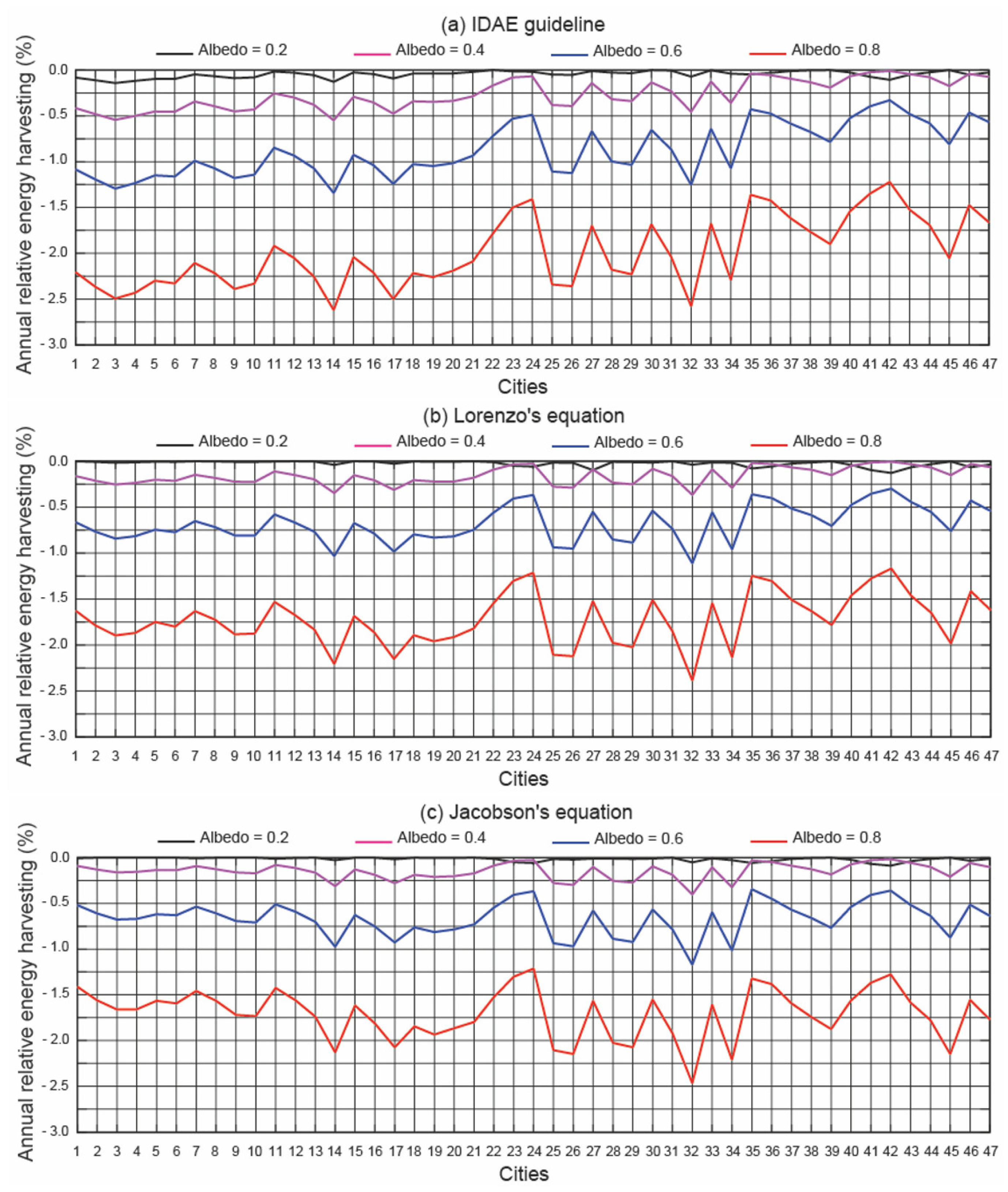

| Parameter | Equations Based on the Latitude | Maximise the Total Solar Irradiance Incident |
|---|---|---|
| Easy to use | Advantage | Disadvantage |
| Prone to error | Disadvantage | Advantage |
| Albedo variation | Disadvantage | Advantage |
| Id | City | Latitude | Longitude | Alt. (m) |
|---|---|---|---|---|
| 1 | Cádiz | 363206 N | 061751 W | 13 |
| 2 | Málaga | 364300 N | 042500 W | 8 |
| 3 | Almería | 365000 N | 02700 W | 16 |
| 4 | Granada | 371041 N | 033603 W | 684 |
| 5 | Huelva | 371500 N | 065700 W | 24 |
| 6 | Sevilla | 372300 N | 055900 W | 11 |
| 7 | Jaén | 374611 N | 034720 W | 570 |
| 8 | Córdoba | 375300 N | 044600 W | 106 |
| 9 | Murcia | 375910 N | 00749 W | 42 |
| 10 | Alicante | 382043 N | 002859 W | 5 |
| 11 | Badajoz | 385249 N | 065831 W | 182 |
| 12 | Ciudad Real | 385900 N | 035500 W | 625 |
| 13 | Albacete | 385944 N | 015121 W | 681 |
| 14 | Valencia | 392800 N | 002230 W | 16 |
| 15 | Cáceres | 392823 N | 062216 W | 457 |
| 16 | Toledo | 395200 N | 040200 W | 516 |
| 17 | Castellón | 395800 N | 000300 W | 27 |
| 18 | Cuenca | 400418 N | 020806 W | 997 |
| 19 | Teruel | 402037 N | 010626 W | 915 |
| 20 | Madrid | 402508 N | 034131 W | 657 |
| 21 | Guadalajara | 403800 N | 031000 W | 685 |
| 22 | Ávila | 403916 N | 044146 W | 1131 |
| 23 | Segovia | 405700 N | 040700 W | 1002 |
| 24 | Salamanca | 405800 N | 053950 W | 798 |
| 25 | Tarragona | 410707 N | 011443 E | 69 |
| 26 | Barcelona | 412257 N | 021037 E | 13 |
| 27 | Zamora | 413012 N | 054520 W | 649 |
| 28 | Lleida | 413700 N | 003800 E | 167 |
| 29 | Zaragoza | 413900 N | 005300 W | 208 |
| 30 | Valladolid | 413907 N | 044343 W | 690 |
| 31 | Soria | 414600 N | 022800 W | 1061 |
| 32 | Girona | 415900 N | 024900 E | 69 |
| 33 | Palencia | 420100 N | 043200 W | 749 |
| 34 | Huesca | 420824 N | 002432 W | 483 |
| 35 | Ourense | 422011 N | 075148 W | 138 |
| 36 | Burgos | 422027 N | 034159 W | 859 |
| 37 | Pontevedra | 422601 N | 083851 W | 16 |
| 38 | Logroño | 422812 N | 022644 W | 384 |
| 39 | León | 423556 N | 053401 W | 837 |
| 40 | Pamplona | 424900 N | 013900 W | 450 |
| 41 | Vitoria | 425048 N | 024023 W | 539 |
| 42 | Lugo | 430042 N | 073326 W | 462 |
| 43 | Bilbao | 431544 N | 025712 W | 6 |
| 44 | San Sebastian | 431900 N | 015900 W | 7 |
| 45 | Oviedo | 432145 N | 055101 W | 231 |
| 46 | A Coruña | 432200 N | 082300 W | 21 |
| 47 | Santander | 432800 N | 034800 W | 8 |
| Id | City | ||||
|---|---|---|---|---|---|
| 1 | Cadiz | 2.1835 | 2.2160 | 2.2485 | 2.2810 |
| 2 | Malaga | 2.1413 | 2.1735 | 2.2056 | 2.2378 |
| 3 | Almeria | 2.1996 | 2.2327 | 2.2659 | 2.2990 |
| 4 | Granada | 2.1746 | 2.2076 | 2.2407 | 2.2737 |
| 5 | Huelva | 2.1807 | 2.2135 | 2.2464 | 2.2792 |
| 6 | Sevilla | 2.1798 | 2.2129 | 2.2460 | 2.2791 |
| 7 | Jaen | 2.1125 | 2.1448 | 2.1771 | 2.2094 |
| 8 | Cordoba | 2.1468 | 2.1797 | 2.2125 | 2.2454 |
| 9 | Murcia | 2.0915 | 2.1244 | 2.1572 | 2.1901 |
| 10 | Alicante | 2.0791 | 2.1116 | 2.1441 | 2.1766 |
| 11 | Badajoz | 2.0697 | 2.1022 | 2.1347 | 2.1672 |
| 12 | Ciudad Real | 2.0931 | 2.1262 | 2.1593 | 2.1923 |
| 13 | Albacete | 2.0819 | 2.1151 | 2.1483 | 2.1815 |
| 14 | Valencia | 2.0813 | 2.1146 | 2.1480 | 2.1813 |
| 15 | Caceres | 2.0774 | 2.1104 | 2.1434 | 2.1764 |
| 16 | Toledo | 2.1014 | 2.1353 | 2.1693 | 2.2032 |
| 17 | Castellon | 2.0247 | 2.0577 | 2.0907 | 2.1237 |
| 18 | Cuenca | 2.0284 | 2.0614 | 2.0945 | 2.1275 |
| 19 | Teruel | 1.9784 | 2.0113 | 2.0443 | 2.0773 |
| 20 | Madrid | 2.0861 | 2.1200 | 2.1539 | 2.1878 |
| 21 | Guadalajara | 2.0297 | 2.0630 | 2.0963 | 2.1295 |
| 22 | Avila | 1.9211 | 1.9529 | 1.9847 | 2.0165 |
| 23 | Segovia | 1.7974 | 1.8272 | 1.8571 | 1.8869 |
| 24 | Salamanca | 1.9174 | 1.9488 | 1.9802 | 2.0116 |
| 25 | Tarragona | 2.0053 | 2.0389 | 2.0725 | 2.1061 |
| 26 | Barcelona | 1.9340 | 1.9655 | 1.9970 | 2.0285 |
| 27 | Zamora | 1.9764 | 2.0094 | 2.0424 | 2.0753 |
| 28 | Lleida | 2.0381 | 2.0723 | 2.1064 | 2.1405 |
| 29 | Zaragoza | 2.0400 | 2.0742 | 2.1084 | 2.1427 |
| 30 | Valladolid | 1.9534 | 1.9862 | 2.0191 | 2.0519 |
| 31 | Soria | 1.8812 | 1.9137 | 1.9462 | 1.9787 |
| 32 | Girona | 1.8900 | 1.9230 | 1.9561 | 1.9891 |
| 33 | Palencia | 1.9291 | 1.9619 | 1.9946 | 2.0274 |
| 34 | Huesca | 2.0624 | 2.09744 | 2.1324 | 2.1674 |
| 35 | Ourense | 1.6929 | 1.7225 | 1.7521 | 1.7817 |
| 36 | Burgos | 1.8359 | 1.8674 | 1.8988 | 1.9303 |
| 37 | Pontevedra | 1.6927 | 1.7221 | 1.7516 | 1.7811 |
| 38 | Logroño | 1.7516 | 1.7825 | 1.8134 | 1.8443 |
| 39 | Leon | 1.9185 | 1.9514 | 1.9843 | 2.0171 |
| 40 | Pamplona | 1.6839 | 1.7140 | 1.7440 | 1.7740 |
| 41 | Vitoria | 1.5168 | 1.5442 | 1.5717 | 1.5991 |
| 42 | Lugo | 1.5733 | 1.6018 | 1.6304 | 1.6589 |
| 43 | Bilbao | 1.4052 | 1.4316 | 1.4579 | 1.4843 |
| 44 | San Sebastian | 1.4011 | 1.4276 | 1.4541 | 1.4806 |
| 45 | Oviedo | 1.4549 | 1.4829 | 1.5109 | 1.5388 |
| 46 | A Coruña | 1.5356 | 1.5640 | 1.5924 | 1.6208 |
| 47 | Santander | 1–4541 | 1.4814 | 1.5088 | 1.5361 |
Publisher’s Note: MDPI stays neutral with regard to jurisdictional claims in published maps and institutional affiliations. |
© 2022 by the authors. Licensee MDPI, Basel, Switzerland. This article is an open access article distributed under the terms and conditions of the Creative Commons Attribution (CC BY) license (https://creativecommons.org/licenses/by/4.0/).
Share and Cite
Barbón, A.; Bayón, L.; Díaz, G.; Silva, C.A. Investigation of the Effect of Albedo in Photovoltaic Systems for Urban Applications: Case Study for Spain. Energies 2022, 15, 7905. https://doi.org/10.3390/en15217905
Barbón A, Bayón L, Díaz G, Silva CA. Investigation of the Effect of Albedo in Photovoltaic Systems for Urban Applications: Case Study for Spain. Energies. 2022; 15(21):7905. https://doi.org/10.3390/en15217905
Chicago/Turabian StyleBarbón, Arsenio, Luis Bayón, Guzmán Díaz, and Carlos A. Silva. 2022. "Investigation of the Effect of Albedo in Photovoltaic Systems for Urban Applications: Case Study for Spain" Energies 15, no. 21: 7905. https://doi.org/10.3390/en15217905
APA StyleBarbón, A., Bayón, L., Díaz, G., & Silva, C. A. (2022). Investigation of the Effect of Albedo in Photovoltaic Systems for Urban Applications: Case Study for Spain. Energies, 15(21), 7905. https://doi.org/10.3390/en15217905







